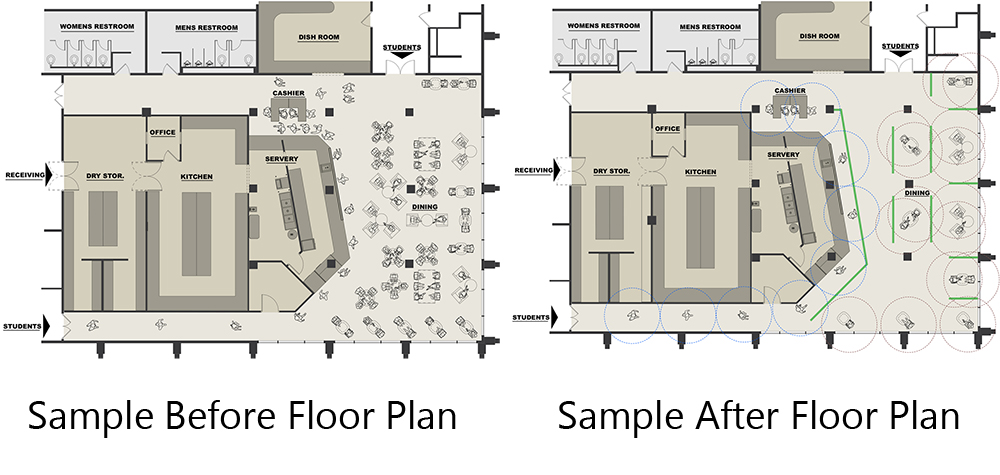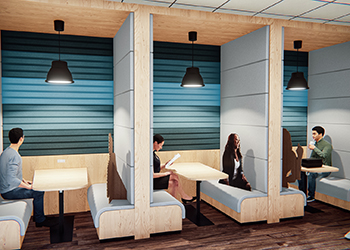Insights: The Future of Campus Food Services
No one will deny that the unprecedented global events of the last few months, due to the spread of COVID-19, has made us all rethink what it means to be safe. In a world brought closer together than ever by technology, we now have to leverage that technology to stay connected in a time when physical proximity to others could have consequences.

Previously, the team at C&S has provided some insights into general “Best Practices” and impacts to the open office concept, as well as other points of discussion, but while everyone has been affected in some way or another by this pandemic, the impact to the food service, restaurant, and hospitality business sector has manifested as a crisis. Roger Lipton, a restaurant industry analyst, investor, and advisor, recently penned a blog post about the upcoming “restaurant apocalypse.” The new norm has changed the very nature of providing customer service, personal attention, and unique culinary experiences, with takeout virtually one of the only options.
This certainly poses a serious conundrum to food service providers at colleges and universities across the country. How is it possible to provide a safe environment (both actual as well as perceptible) to returning students, faculty, and administration without compromising quality, service, variety of offerings, and the student campus experience? Having designed a variety of food service venues in the last 30 years, we have noticed that while change is inevitable in the food industry, when handled creatively and holistically, the result can create a new “norm”. Trends such as marché “front-cooking” dining, “farm to table,” “flexitarian,” etc., have shaped the culinary experience of students on college campuses. While the pandemic certainly has negatively influenced the industry, the possible remedies that result from this situation have the opportunity to allow everyone to safely enjoy eating on campus.
Campuses are currently assessing the financial impacts of COVID-19 on future student enrollment, retention, and on-campus presence with projected reduction in revenue. It is unlikely that campus administrations will be undertaking large-scale capital investments to address new food service operations anytime soon. So here are a few ideas of what the immediate future of the campus food service may look like, assuming a low or limited facility capital investment to achieve social distancing recommendations.
“Alright People! Break it Up!”
We have all heard about the CDC recommended six-foot distance we are to keep from one another to limit the spread of infection and the guidelines for large crowd gatherings. The “easy’’ solution from a space utilization standard is to eliminate seats and spread them sufficiently apart to meet the requirements. While removing chairs implies less participation at any one time, this would also need to be coupled with techniques utilized by food markets including staff trained to count occupancy numbers to meet the new maximum occupancy, as well as floor mounted signage that would guide proper queuing to venues. In all, temporarily removing furniture is the most flexible option open to providers.

“All I Need are my Friends!”

An alternative to removing seating is to leave the seats, but make them ”unavailable”. A kind of light-spirited alternative to physically removing seats, utilized by a number of international restaurants, includes the creative use of “stand-ins”. For example, some upscale restaurants have placed well-dressed mannequins, large stuffed animals, life-size cardboard cutouts of people sitting (and seemingly having a good time), or 3-D printed cardboard school mascots strategically situated to help keep people apart, without the space looking empty or unwelcoming.
“I Just Need my Space”

Another creative idea is the addition of privacy (separation) screens between tables or seats. Whether they are transparent, translucent, or opaque, these screens can provide a sense of privacy to smaller group diners, with little or no impact to the overall space aesthetics or to existing mechanical or fire protection systems if they remain at standing height or below. The next step in this dining concept is to create more booth type seating, which by its nature encourages small group gathering by its limited capacity. Booth seating can also provide the opportunity for creating a perceived “protected” area, as it is enclosed on two to three sides.
“No one is an Island”

While we certainly do not wish anyone to feel isolated, a next level of design solution is creating smaller partitioned areas that limit the size of groups able to congregate. Some enterprising establishments have installed small greenhouse type structures, creating the feeling of being in private outdoor cafés while maintaining social distancing protocols. This can be coupled with biophilic design principles, which strive to connect diners with nature through a multisensory experience – through sight, sound, and taste.
As there are no current campus food service design guidelines for operating in a pandemic and post-pandemic environment, following practical, thoughtful, and creative design approaches remains the most successful methodology to meet social distancing requirements and create a singular dining experience for your customers.
Richard Napoli, AIA
Managing Architect
To discuss layout options for your food service areas, Richard can be reached at rnapoli@cscos.com or (585) 325-9040.